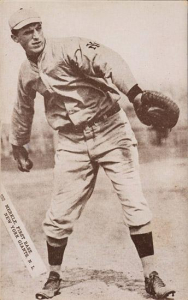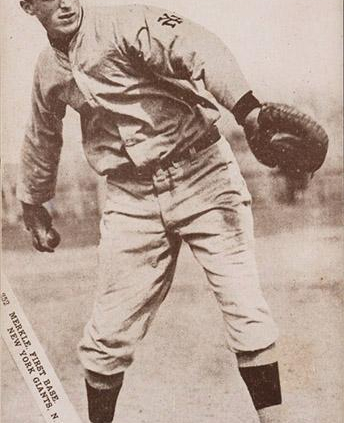Fred Merkle
 Due to a single base-running blunder on September 23, 1908, Fred Merkle became known by such unflattering epithets as “Bonehead,” “Leather Skull,” and “Ivory Pate.” Those who knew the right-handed cleanup hitter, however, described him as a “gentleman and scholar” and “voracious reader”; in fact, teammate Chief Meyers called him “the smartest man on the club.” Baseball Magazine described the 6’1″, 190 pound Merkle as “a hard hitter who usually delivers in the pinches” and “the most finished fielder in his league,” but what really set him apart from other first basemen was his ability as a base runner. One of the few Deadball Era players who routinely slid head-first, Merkle “was not what one could call a very fast man on a sprint,” wrote John McGraw, “but he was adept at stealing third. He never started unless he had the right lead, and once he started he rarely missed.”
Due to a single base-running blunder on September 23, 1908, Fred Merkle became known by such unflattering epithets as “Bonehead,” “Leather Skull,” and “Ivory Pate.” Those who knew the right-handed cleanup hitter, however, described him as a “gentleman and scholar” and “voracious reader”; in fact, teammate Chief Meyers called him “the smartest man on the club.” Baseball Magazine described the 6’1″, 190 pound Merkle as “a hard hitter who usually delivers in the pinches” and “the most finished fielder in his league,” but what really set him apart from other first basemen was his ability as a base runner. One of the few Deadball Era players who routinely slid head-first, Merkle “was not what one could call a very fast man on a sprint,” wrote John McGraw, “but he was adept at stealing third. He never started unless he had the right lead, and once he started he rarely missed.”
The son of Ernest, a German immigrant, and Amalie (Thilghman) Merkle, Carl Frederick Rudolf Merkle was born on December 20, 1888, in Watertown, Wisconsin. Fred grew up in Toledo, Ohio, where he went to school and earned regional recognition as a star halfback in football and fastball pitcher in baseball, playing under the Americanized name he had adopted, Frederick Charles Merkle. He pitched for semipro teams in Toledo starting in 1905 and tried out with Newark in the Ohio-Pennsylvania League in 1906. Later that season Fred signed to play third base with Tecumseh in the South Michigan League but was quickly shifted to first base. Returning to Tecumseh in 1907, the 18-year-old Merkle batted .271 and led the league with six home runs, prompting his purchase by the New York Giants for $2,500. Making his major-league debut on September 21, Fred appeared in 15 games and batted .255.
Fred played in 38 games in 1908, but he is most remembered for the one game in which he appeared in the starting lineup. On September 23, in the final two weeks of a sweltering National League pennant race between the Giants, Cubs, and Pirates, Merkle substituted at first base for the injured Fred Tenney. In the bottom of the ninth at the Polo Grounds, the Giants and Cubs were tied, 1-1. With two out and Moose McCormick on first base, Merkle drove a long single into the right-field corner, sending McCormick to third. The next batter, shortstop Al Bridwell, lined Jack Pfiester‘s offering up the middle, knocking umpire Bob Emslie from his feet. When McCormick scored the would-be winning run, the fans at the Polo Grounds went wild and swarmed onto the diamond.
According to his own affidavit, Merkle was about 15 feet from second base when he veered towards the clubhouse in center field. Chicago center-fielder Artie Hofman had fielded Bridwell’s hit and thrown the ball to second baseman Johnny Evers, but somehow Giants pitcher Joe McGinnity came up with the ball and lobbed it deep into the crowd.
While Evers was trying to recover Hofman’s throw, Merkle claims he returned to second base and stood there while the Cubs protested. He remained there until Christy Mathewson came along and said, “Come on, let’s go to the clubhouse. Emslie said he would not allow the claim.” Evers, who eventually found another ball somewhere, clamored for the attention of home-plate umpire Hank O’Day, claiming that Merkle had failed to touch second. O’Day called Merkle out on a force play. Judging that the spectators couldn’t be cleared from the field to allow play to resume, O’Day declared the game a tie, a decision that was upheld on appeal. “Merkle was careless, to be sure,” wrote Baseball Magazine, “but withal, he did only what many others had done without suffering criticism.”
Arguably Merkle’s “boner” cost the Giants the 1908 pennant, though McGraw always defended him, pointing out that his team had lost a dozen other games that it should have won that season. Nonetheless the misplay continued to haunt Merkle, who batted only .191 without a single home run in 79 games the next season. “Listen to them hoot,” he reportedly said to the manager. “You’re making a mistake to keep me here. They don’t want me.” McGraw replied, “I wish I had more players like you. Don’t pay any attention to those weathercocks. They’ll be cheering you the next time you make a good play.” McGraw’s patience was rewarded in 1910 when Merkle replaced Tenney and batted .292 with 70 RBI as the Giants regular first baseman and cleanup hitter. The next year he batted .283 with career highs in home runs (12), RBI (84), and stolen bases (49), finishing seventh in the Chalmers Award voting. One of his dozen homers was reportedly “the longest four-base hit ever seen on the Cincinnati grounds.”
Merkle enjoyed his finest season in 1912 when he batted a career-high .309 with 11 home runs, 84 RBI, and 37 stolen bases. In Game Eight of that year’s World Series against the Boston Red Sox, however, he figured in another luckless play. Fred was poised to be the hero when his single in the top of the 10th inning scored Red Murray from second to give the Giants the lead. The bottom half began with Fred Snodgrass‘ infamous muff in center field, allowing pinch-hitter Clyde Engle to reach second base. After Harry Hooper flied out and Steve Yerkes walked, Tris Speaker hit a high foul near the first-base coach’s box. Though most observers agreed that it was his ball, Merkle backed away when Mathewson called for the catcher, Meyers, to make the catch. The ball fell to the ground, giving Speaker another chance, and this time he slashed a long single to right that started the Sox’s winning rally. In New York, the headlines the next day read “Bonehead Merkle Does It Again.”
Performing well as the regular first baseman through 1915, Merkle was batting an uncharacteristic .237 when the Giants traded him to the Brooklyn Robins for catcher Lew McCarty in August 1916. Filling in at first base for the injured Jake Daubert, Fred played in 23 games for Brooklyn down the stretch and got into three games during the 1916 World Series. When Chicago Cubs first-baseman Vic Saier broke his leg early in 1917, the Robins sold Merkle to Chicago for $3,500. He remained in the Cubs starting lineup for three years, playing in another World Series in 1918. Though he was only 31 years old, Merkle’s National League career ended in 1920, after which he put up consistently huge numbers in four years as the first baseman for Rochester of the International League.
After the 1924 season, in which Merkle batted .351 and slammed 22 home runs, The Sporting News reported that Rochester manager George Stallings was willing to trade his star first baseman to the New York Yankees as back-up insurance for Wally Pipp but expected young Louis Gehrig in return. In June 1925 the Yankees did acquire Merkle, but they elected to hold on to Gehrig and part with $6,000 instead. Fred remained as a coach and occasional player through 1926, when he became a member of his sixth losing World Series team. After the season the Yankees released him to make room for his former Giants teammate Art Fletcher as the head coach. Merkle started the 1927 season as player-manager of Reading in the International League but was dismissed in June after playing in only 38 games. Two years later he managed the team from his new hometown of Daytona, but his tenure was short-lived: one day a player referred to him as a bonehead; Merkle walked off the diamond and never returned.
Over the course of his career, Merkle saved enough of his baseball earnings to move to Daytona Beach, Florida, and purchase a farm where he raised fruit crops. The Depression hit him hard and he was forced to work on a WPA county bridge project until his fortunes picked up after World War II, when he became a partner in a firm that manufactured fishing lures. Though Fred shunned reporters, who usually only wanted to ask him about his bonehead play, he was a regular at Daytona Beach Islanders games and baseball clinics. Merkle spent his retirement playing bridge, golf, and chess. Above average at all three games, Fred was a fixture at the bridge table with McGraw and Mathewson during his years with the Giants, and he was also one of the first active ballplayers to make a serious hobby of golf. On March 2, 1956, in Daytona Beach, the 67-year-old Merkle was out shopping when he became ill, asked for his pills, lay down, and died.
NOTE: An earlier version of this biography appeared in Tom Simon, ed., Deadball Stars of the National League (Washington, D. C.: Brassey’s Inc., 2004).
- Related link: Click here to download the SABR Deadball Era Research Committee’s September 2008 newsletter, a special 100th anniversary edition focused on the Merkle Game (PDF)
Sources
Anderson, David. More Than Merkle. University of Nebraska, 2000.
Graham, Frank. The New York Giants. Putnam, 1952.
Kofoed, J. C. “The Most Unfortunate Man in Baseball.” Baseball Magazine. March, 1915.
National Baseball Hall of Fame Clipping File.
Shatzkin, Mike. The Ballplayers. William Morrow, 1990.
Full Name
Carl Frederick Rudolf Merkle
Born
December 20, 1888 at Watertown, WI (USA)
Died
March 2, 1956 at Daytona Beach, FL (USA)
If you can help us improve this player’s biography, contact us.


